popol vuh
︎Spirituality, Illustration, Animation
︎ Ventral Is Golden
popol vuh
︎Spirituality, Illustration, Animation
︎ Ventral Is Golden
︎ Ventral Is Golden
"We shall write about this now amid the preaching of God. We shall bring it out because there is no longer a place to see it, a Council Book, a place to see The Light That Came from Beside the Sea, the account of Our Place in the Shadows, a place to see The Dawn of Life." - Popol Vuh.
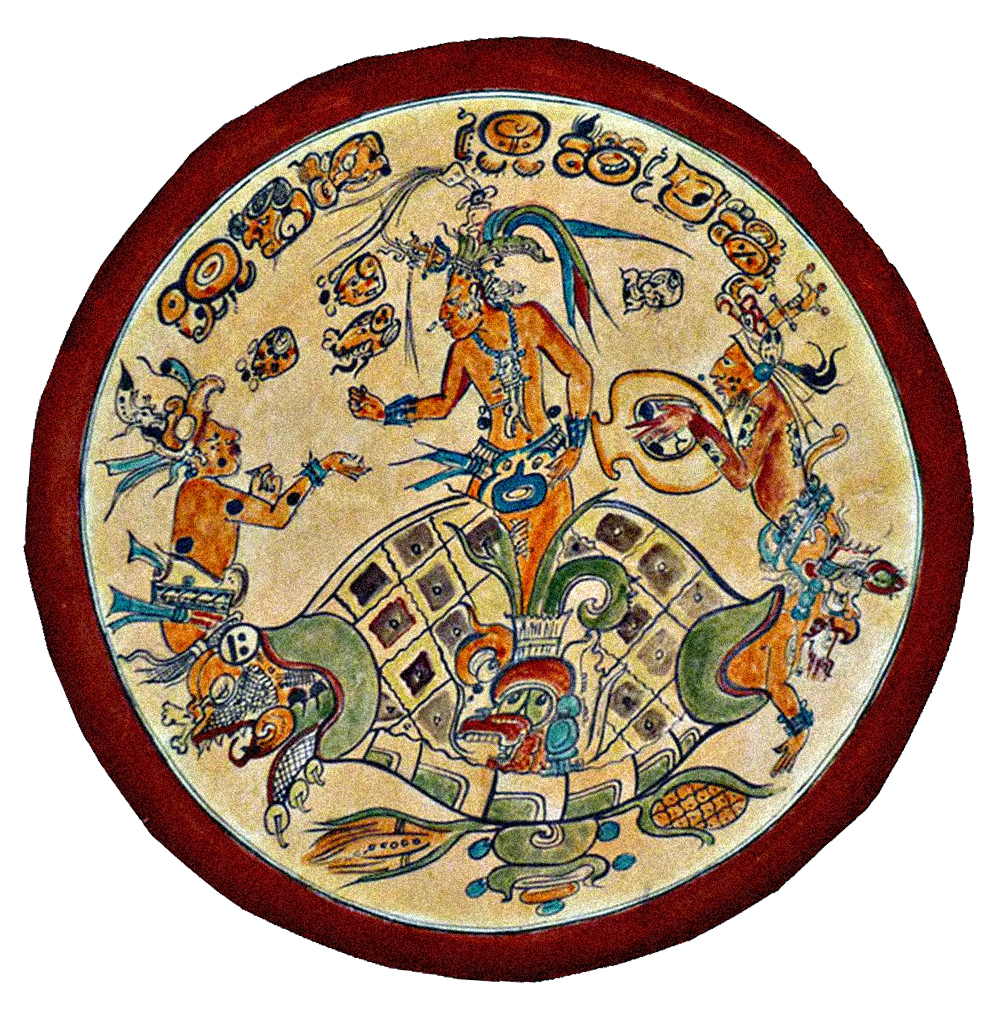
In his book, Infancy and History: On the Destruction of Experience, bio-political philosopher, Giorgio Agamben writes that “every culture is first and foremost a particular experience of time, and no new culture is possible without an alteration in this experience. The original task of a genuine revolution, therefore, is never merely to 'change the world', but also - and above all - to 'change time’.”
A change in time was certainly being imposed upon the Mayan culture during the colonial rule and was most likely the motivation behind the re-writing and translation of the sacred Popol Vuh.
Written in the 16th Century, sometime between 1550 and 1558 by a group of unknown mayan authors, who had memorised their mythology through centuries of oral traditions, dating back to the Olmecs (the earliest known civilisation of Meso-America), the Popol Vuh, translated as “The Book of the Community” or “The Book of the People”, recounts the mythological history of the Mayan people who inhabit modern day Guatemala and the Mexican states of Chiapas, Campeche, Yucatan and Quintana Roo, as well as areas of Belize, Honduras and El Salvador.
Only a handful of Maya texts are still in existence today as a result of the systematic burning of all texts relating to ancient cosmological time, astrology, astronomy and the natural sciences, alongside the destruction of temples and cult imagery. Ordered by the Roman Catholic bishop, Diego de Landa, in the municipality of Mani on July 12, 1562, approximately 5,000 Maya cult images and a disputed number of Maya codices (philosophies on ancient knowledge) thought to number at least 27, were all burned.
Only four incomplete codices remain.
In addition to these four codices are texts that were transcribed or translated during the colonial era via the memory of the mayan priestly communities. The Popol Vuh is one of these texts, yet its importance within the context of ancient Mayan history is verified by depictions of scenes within the text upon temple walls and on pottery that date to the pre-classic era of 1800BC.
A change in time was certainly being imposed upon the Mayan culture during the colonial rule and was most likely the motivation behind the re-writing and translation of the sacred Popol Vuh.
Written in the 16th Century, sometime between 1550 and 1558 by a group of unknown mayan authors, who had memorised their mythology through centuries of oral traditions, dating back to the Olmecs (the earliest known civilisation of Meso-America), the Popol Vuh, translated as “The Book of the Community” or “The Book of the People”, recounts the mythological history of the Mayan people who inhabit modern day Guatemala and the Mexican states of Chiapas, Campeche, Yucatan and Quintana Roo, as well as areas of Belize, Honduras and El Salvador.
Only a handful of Maya texts are still in existence today as a result of the systematic burning of all texts relating to ancient cosmological time, astrology, astronomy and the natural sciences, alongside the destruction of temples and cult imagery. Ordered by the Roman Catholic bishop, Diego de Landa, in the municipality of Mani on July 12, 1562, approximately 5,000 Maya cult images and a disputed number of Maya codices (philosophies on ancient knowledge) thought to number at least 27, were all burned.
Only four incomplete codices remain.
In addition to these four codices are texts that were transcribed or translated during the colonial era via the memory of the mayan priestly communities. The Popol Vuh is one of these texts, yet its importance within the context of ancient Mayan history is verified by depictions of scenes within the text upon temple walls and on pottery that date to the pre-classic era of 1800BC.

︎ Mayan Scribe.
A pre-existing text of the Popol Vuh, that was used as the basis of the translation, was held most sacred by the local mayan priests on account that the written word was an ilb’al - ‘an instrument of sight’ by which the reader may “envision” the thoughts and actions of the gods and
ancestors from the beginning of time and into the future, as if creation were occuring in the immediate present, with time
folding back upon itself to transport the reader into the primordial waters of chaos at the very
moment the first lands emerged (source).
This idea is most poetically and graphically represented on an incised bone found in Tikal, depicting a hand holding a calligraphic pauntbrush whilst emerging from the jaws of a serpent. In Classic Maya art, the open jaws represent a threshold between sacred and profane worlds that are characterised by a change in time and thus a shift in consciouness. The message of this incised bone is that the scribal arts invoke and summon energy as thought.
It wasn’t until around 1701 that a Spanish friar named Francisco Ximénez happened to glimpse this original text as he was serving as the parish priest. Ximénez, who had gained the trust of the local mayan community, and as the local priests had realised that their ancient beliefs would no longer be tolerated by their Christian conquerors, allowed Ximénez to see this original text, which has since either disappeared or remains hidden by the Kiche maya for its protection, making the copy made by Ximénez the only known example that survives today.
This idea is most poetically and graphically represented on an incised bone found in Tikal, depicting a hand holding a calligraphic pauntbrush whilst emerging from the jaws of a serpent. In Classic Maya art, the open jaws represent a threshold between sacred and profane worlds that are characterised by a change in time and thus a shift in consciouness. The message of this incised bone is that the scribal arts invoke and summon energy as thought.
It wasn’t until around 1701 that a Spanish friar named Francisco Ximénez happened to glimpse this original text as he was serving as the parish priest. Ximénez, who had gained the trust of the local mayan community, and as the local priests had realised that their ancient beliefs would no longer be tolerated by their Christian conquerors, allowed Ximénez to see this original text, which has since either disappeared or remains hidden by the Kiche maya for its protection, making the copy made by Ximénez the only known example that survives today.
“When all is still silent and placid. All is silent and calm. Hushed and empty is the womb of the sky. The face of the earth has not yet appeared. Alone lies the expanse of the sea, along with the womb of all the sky. There is not yet anything gathered together. All is at rest. Nothing stirs.”

︎ Mayan Scribal glyph on incised bone, Tikal.
In the tradition of Western philosophy sourced from Aristotle, the definition of time was thought of as a quantity of movement, who’s continuity is assured by its division into discrete instants, analogous to a geometric point, which ultimately gives time the character of being ‘other’ or ‘outside’ of nature (source). The Western philosopher’s incapacity to master time, and his consequent obsession with gaining it, have their origins in this idea and are picked up by later Christian thought, which resolutely separates time from the natural movement of the stars to make it an essentially human construct and an interior phenomena.
This existential paradox can be attributed to the systematic destruction of all ancient texts relating to astrology and myth, and the attempted eradication of hieroglyphic writing by extension, which for the Maya, being expressed very intrinsically with the energies ascribed to each day (k’in), was directly connected with this change in the perception of nature and time as a spherical, cosmic environment, filled with deep mathematical energetics and a complex philosophical understanding that rendered time a kind of substance or living entity.
Even Mayan priests, in both ancient and contemporary contexts, who were held in high regard in creative society for their ability to write and express poetry (called xochicuicatl - “flower-song” in the Nahuatl of the later Aztecs), are also called Aj q'ijab' (They of Days, or Daykeepers).
The energetics of time were central to the philosophy preserved by the Mayan culture and expressed in their calendrical systems.
These systems in fact span across at least three different cultures, the earliest dating to the Olmecs, then the Mayan culture of the Yucatan and surrounding areas and later into the Aztecs (Mexica) of Central Mexico.
The energetics were by most accounts expressed in a similar manner cross-culturally, with the Tzolki’n of the Maya and the Tonalpohualli of the Aztecs being used as the sacred lunar calendars, where the quality of time was embedded into the glyph that represented each of the twenty day names - known as Nahuales (or animal co-essences that comprised part of the human soul).
In the Popol Vuh, this quality of time also envelops the four initial ages of humanity, with each age or era having a distinct temperament. The end result of these ages is an evolution in the general structure of consciousness through the differentiation of three worlds common to much of pre-historical mythology: the heavens, the earth, and the underworld.
The fall from the original state of union with the gods (who are themselves expressions of universal forces) is accompanied by the knowledge of the soul as that which weaves a world between spirit and matter.
This existential paradox can be attributed to the systematic destruction of all ancient texts relating to astrology and myth, and the attempted eradication of hieroglyphic writing by extension, which for the Maya, being expressed very intrinsically with the energies ascribed to each day (k’in), was directly connected with this change in the perception of nature and time as a spherical, cosmic environment, filled with deep mathematical energetics and a complex philosophical understanding that rendered time a kind of substance or living entity.
Even Mayan priests, in both ancient and contemporary contexts, who were held in high regard in creative society for their ability to write and express poetry (called xochicuicatl - “flower-song” in the Nahuatl of the later Aztecs), are also called Aj q'ijab' (They of Days, or Daykeepers).
The energetics of time were central to the philosophy preserved by the Mayan culture and expressed in their calendrical systems.
These systems in fact span across at least three different cultures, the earliest dating to the Olmecs, then the Mayan culture of the Yucatan and surrounding areas and later into the Aztecs (Mexica) of Central Mexico.
The energetics were by most accounts expressed in a similar manner cross-culturally, with the Tzolki’n of the Maya and the Tonalpohualli of the Aztecs being used as the sacred lunar calendars, where the quality of time was embedded into the glyph that represented each of the twenty day names - known as Nahuales (or animal co-essences that comprised part of the human soul).
In the Popol Vuh, this quality of time also envelops the four initial ages of humanity, with each age or era having a distinct temperament. The end result of these ages is an evolution in the general structure of consciousness through the differentiation of three worlds common to much of pre-historical mythology: the heavens, the earth, and the underworld.
The fall from the original state of union with the gods (who are themselves expressions of universal forces) is accompanied by the knowledge of the soul as that which weaves a world between spirit and matter.
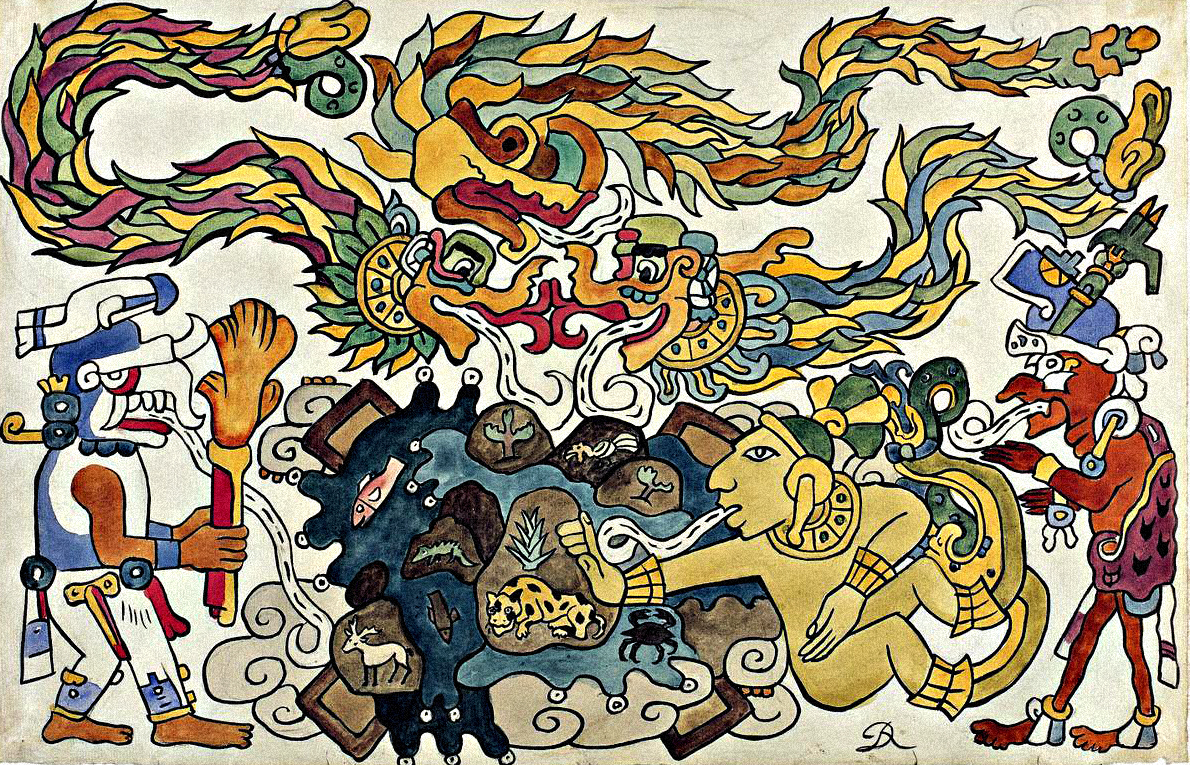
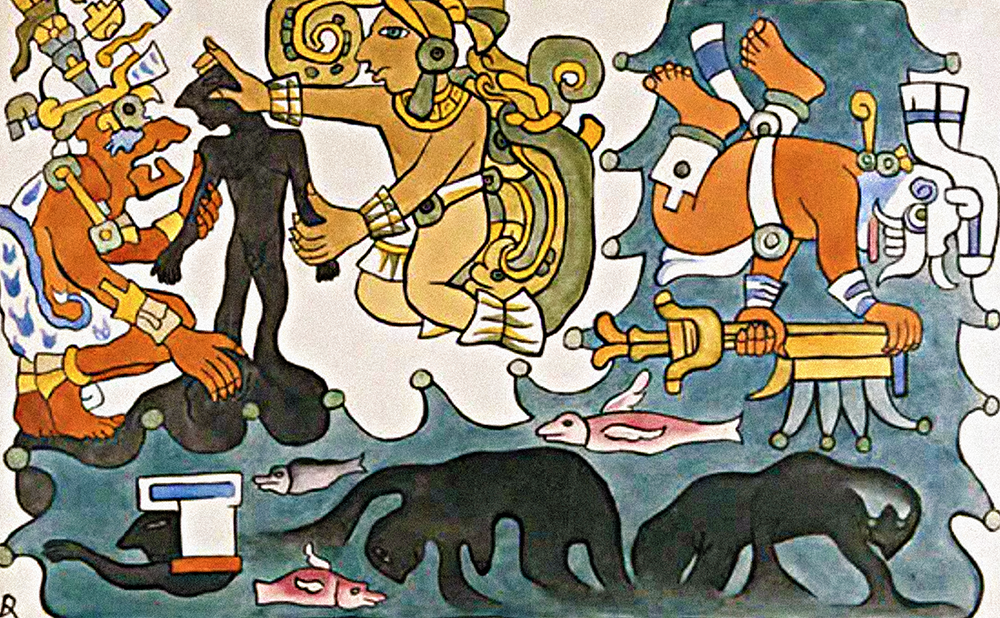

︎ Watercolour illustrations by Diego Rivera (1930).

︎ Mayan Cosmogensis, watercolour by Diego Rivera (1930).
“The first men to be created and formed were called the Sorcerer of Fatal Laughter, the Sorcerer of Night, Unkempt, and the Black Sorcerer. They were endowed with intelligence, they succeeded in knowing all that there is in the world. When they looked, instantly they saw all that is around them, and they contemplated in turn the arc of heaven and the round face of the earth. Then the Creator said, 'They know all… what shall we do with them now? Let their sight reach only to that which is near; let them see only a little of the face of the earth! Are they not by nature simple creatures of our making? Must they also be gods?” - Popol Vuh.

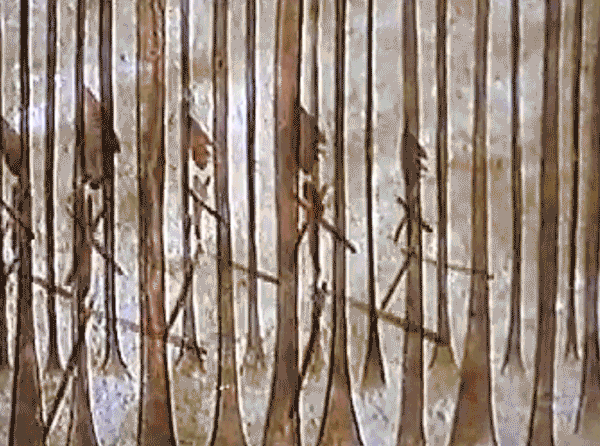

︎ Popol Vuh, amination by Patricia Amlin (1989).
The first era was the creation of a race of giants, beings that lived very close to an animalistic union, a pre-individualistic age where many global accounts of this era recalled the building of monolithic structures. The gods urged the giants to call upon their creators as a sign of respect, but none could speak, using only a form of telepathy or pre-verbal insight as communication, and so their bodies were sacrificed as a result of these abilities incarnating too soon in the development of humanity.
The second race of human beings were created from earth and mud, they were kind hearted but lacked cohesion and strength. They could speak but had no reason or sense. The gods ended this era in a great flood that turned the people into fish.
Now the creator gods called upon the help of the ancient grandparents, Ixpiyacoc (divine male) and Ixmucané (divine female), both described as soothsayers, who would help in the next phase of creation known as the era of the Wooden people. These resembled humans, could talk and spread over the earth, but they lacked soul, reason, and any memory of their creators. Their forgetfulness and materialism was the source of their downfall, and so Heart of Sky caused another flood that brought about the end of this civilisation.
At this third stage, for the first time, the Popol Vuh mentions an explicit differentiation of the sexes. However, human beings still lacked a self awareness and did not remember their creators. And so another flood brought this phase to an end and the very few who survived retreated into the forests and became monkeys.
The second race of human beings were created from earth and mud, they were kind hearted but lacked cohesion and strength. They could speak but had no reason or sense. The gods ended this era in a great flood that turned the people into fish.
Now the creator gods called upon the help of the ancient grandparents, Ixpiyacoc (divine male) and Ixmucané (divine female), both described as soothsayers, who would help in the next phase of creation known as the era of the Wooden people. These resembled humans, could talk and spread over the earth, but they lacked soul, reason, and any memory of their creators. Their forgetfulness and materialism was the source of their downfall, and so Heart of Sky caused another flood that brought about the end of this civilisation.
At this third stage, for the first time, the Popol Vuh mentions an explicit differentiation of the sexes. However, human beings still lacked a self awareness and did not remember their creators. And so another flood brought this phase to an end and the very few who survived retreated into the forests and became monkeys.
The fourth stage marked another turning point in the structure of consciousness via the transitioning of time from mythical to historical.
It is here in the fourth era that the Mayan Long Count calendar begins, in August 3114BC, marking the start of a new 13 Baktun cycle. Likewise, the narrative of the Popol Vuh changes course here and introduces the mythical Hero Twins, Hunahpu and Xbalanque, as well as their archetypal father figues 1 Hunahpu and 7 Hunahpu. Their numerological archetypes are integral to understanding the sacred geometry encoded within the text.
It is here in the fourth era that the Mayan Long Count calendar begins, in August 3114BC, marking the start of a new 13 Baktun cycle. Likewise, the narrative of the Popol Vuh changes course here and introduces the mythical Hero Twins, Hunahpu and Xbalanque, as well as their archetypal father figues 1 Hunahpu and 7 Hunahpu. Their numerological archetypes are integral to understanding the sacred geometry encoded within the text.
“In the darkness before creation was complete, the gods sent a great flood that wiped out humanity. The sky had been formed by the Maker, mother and father of all, the great Feathered Serpent. The gods had raised the mountains of the earth from the face of the murmuring sea. But the creation of humanity had been a dismal failure. Humans made of wood babbled senselessly before crumbing away. So the gods made puppets without strings, carved as humans. But their wooden heads were empty. They couldn't remember their makers with praise, so the gods sent the flood. In this time of darkness were born twins named One and Seven Hunahpu.”
- Popol Vuh.
- Popol Vuh.
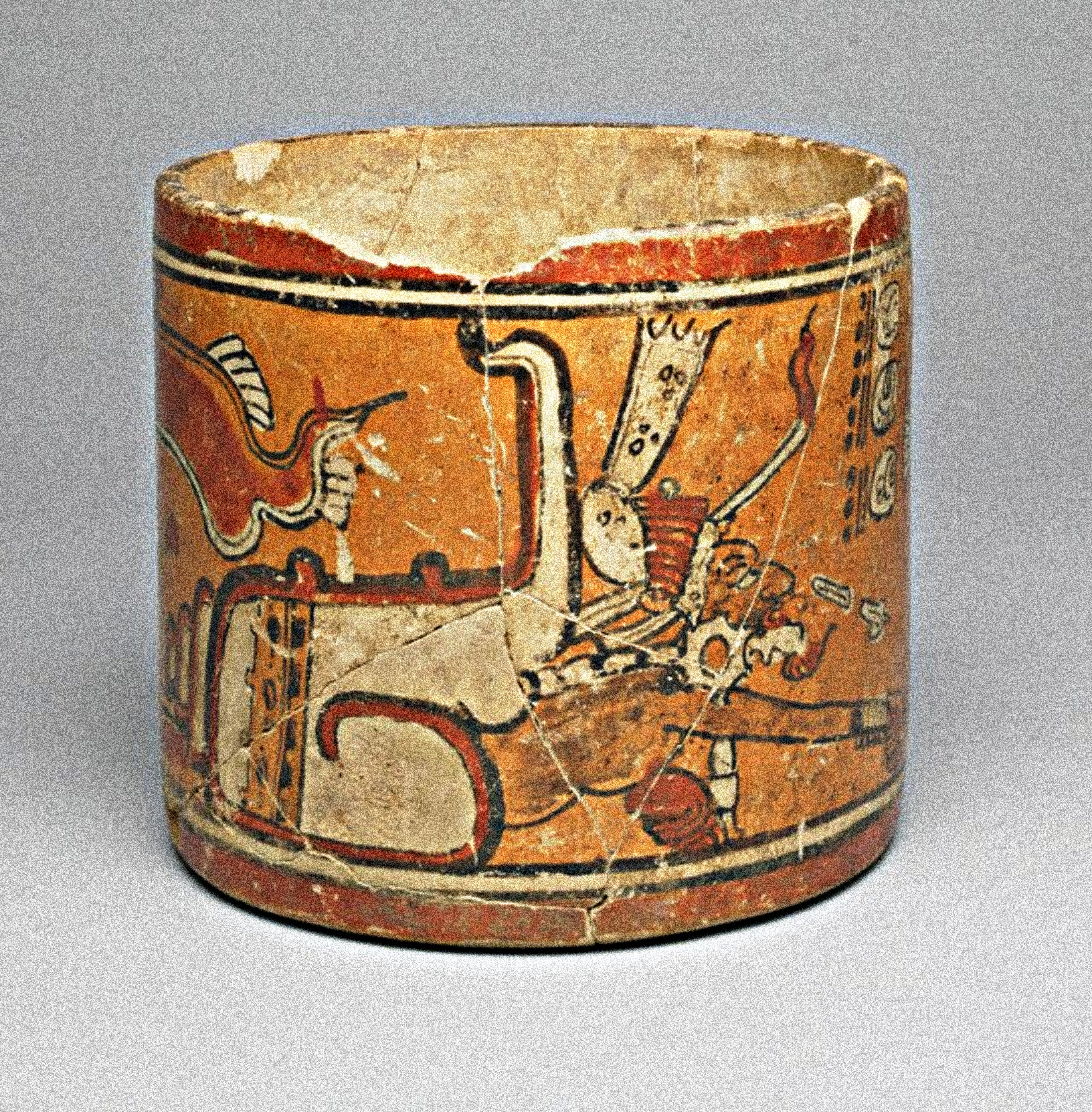


︎ Ceremonial Cacao cup,
depicting the story of the Hero Twins.
depicting the story of the Hero Twins.

︎ Hunahpu and Ixbalanque (The Hero Twins).

︎ The head of Hunahpu regenerating on the tree of life as a Calabash or Cacao pod (centre).
It is common knowledge in most modern Mayan communities that the Tzolk’in (the sacred lunar calendar which is composed of 20 male day signs and 13 female moon signs) is derived from the 13 joints of the human body, approximately 13 lunations in one solar year and that its 260 day total (13 x 20) is roughly the gestation period of a human baby.
Given that the Mayan perception of time implies that number is a type of energy that the sun gives to each day, it is no coincidence that the importance of the 1 and 7 in the Popol Vuh correspond to a spectrum of meanings relating to the effects of time upon the physical and spiritual domains. For example; the structure of mayan cosmology is composed of 13 spheres of heaven and 9 underworlds, where 7 represents the mid-point of a spiritual ascension upon the physical plane (and the Hero Twins are described as “the mid-most seers upon the face of the earth”), whilst the 1 and the 7 together can invoke the completion of an entire cycle, as the sequence of day names fall in the order of 1, 8, 2, 9, 3, 10, 4, 11, 5, 12, 6, 13 and 7 (source).
Additionally, the completion of an age, a cycle, or a Sun, are similarly comprised of 13 Baktuns (1,872,000 days or 144,000 days each). This is a number that contains sacred geometric attributes, in that one Baktun is a multiple of 1440, the amount of degrees found in the interior angles of the Platonic Solid that signifies ‘Air’ - which is also the number of minutes it takes the earth to make one rotation.
Contemporary philosopher and cofounder of the Mayan Dream Spell Calendar, Jose Arguelles, succinctly stated in his ‘Treatise on Time’ that “just as air is the atmosphere of the body, so time is the atmosphere of the mind” and the Popol Vuh seems to embed the psychology of these numerical reflections into the dynamic symmetry that underlies all expressions that bind the earthly and cosmic planes together.
Given that the Mayan perception of time implies that number is a type of energy that the sun gives to each day, it is no coincidence that the importance of the 1 and 7 in the Popol Vuh correspond to a spectrum of meanings relating to the effects of time upon the physical and spiritual domains. For example; the structure of mayan cosmology is composed of 13 spheres of heaven and 9 underworlds, where 7 represents the mid-point of a spiritual ascension upon the physical plane (and the Hero Twins are described as “the mid-most seers upon the face of the earth”), whilst the 1 and the 7 together can invoke the completion of an entire cycle, as the sequence of day names fall in the order of 1, 8, 2, 9, 3, 10, 4, 11, 5, 12, 6, 13 and 7 (source).
Additionally, the completion of an age, a cycle, or a Sun, are similarly comprised of 13 Baktuns (1,872,000 days or 144,000 days each). This is a number that contains sacred geometric attributes, in that one Baktun is a multiple of 1440, the amount of degrees found in the interior angles of the Platonic Solid that signifies ‘Air’ - which is also the number of minutes it takes the earth to make one rotation.
Contemporary philosopher and cofounder of the Mayan Dream Spell Calendar, Jose Arguelles, succinctly stated in his ‘Treatise on Time’ that “just as air is the atmosphere of the body, so time is the atmosphere of the mind” and the Popol Vuh seems to embed the psychology of these numerical reflections into the dynamic symmetry that underlies all expressions that bind the earthly and cosmic planes together.
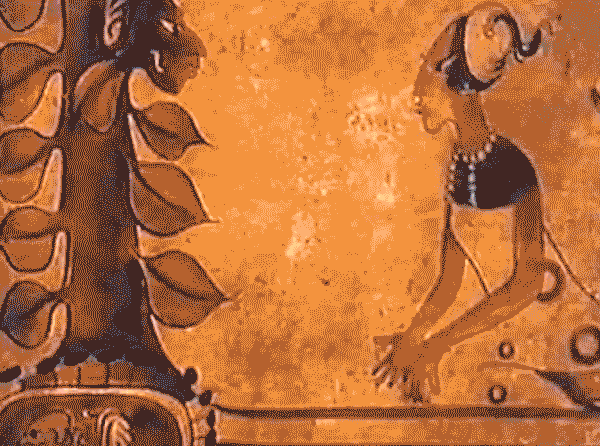
︎ ‘The Immaculate Conception’ of Xquic (Blood Woman).
.
Another phenomena contained within these sacred numbers that measure the earth’s movement in relation to the sun and the moon, is that they all reduce to 9 by adding their digits together - which coincidentally is the number of levels in the Mayan underworld (Xibalba).
This is a significant piece of information that relates to the concept of the fall from the state of union with the original creator gods ( Heart of Sky, the Framer, the Shaper and Sovereign Feathered Serpent), who themselves represent the powerful natural forces that bring the spirit of regeneration into the material world via the archetype of the ‘Immaculate Conception’, as seen throughout all world mythology, as well as being articulated as the descent into the underworld of 1 and 7 Hunaphu and their offspring, the Hero Twins.
This is a significant piece of information that relates to the concept of the fall from the state of union with the original creator gods ( Heart of Sky, the Framer, the Shaper and Sovereign Feathered Serpent), who themselves represent the powerful natural forces that bring the spirit of regeneration into the material world via the archetype of the ‘Immaculate Conception’, as seen throughout all world mythology, as well as being articulated as the descent into the underworld of 1 and 7 Hunaphu and their offspring, the Hero Twins.
The conception of the Mayan underworld (Xibalba) is not only a place characterised by the limited moralistic ideas of good and evil, but is also an unseen dimension through which all of the upperworlds emerge. This is consistent with the belief that caves, called ‘Pib Na’ in some maya regions, represented physical entrances into Xibalba as well as being the word for sweat baths and holes made in the ground for planting seeds. Collective linguistic concepts where energies can mingle into eachother established poetic relationships with the world, as all these artefacts of cultural thought were seen as regenerative places or ‘houses of the soul’ that provided internal heat for growth.
As the ruling deities of this unseen dimension are also named 1 and 7 Death, they act as a reflection of the material world of Hunaphu and Ixbalanque, who’s descent and subsequent resurrection brings about a new era (or a new Sun) in the social and spritual structure of time on earth.
This new dawning is characterised by the placing of ‘three stones in the sky’ and the cultivation of corn as a central food source, bringing us back to the fourth stage of the Popol Vuh’s creation story and the beginning of the era which characterises the current expression of humanity.
![]()
︎ Mayan Maize God emerging from a flower.
As the ruling deities of this unseen dimension are also named 1 and 7 Death, they act as a reflection of the material world of Hunaphu and Ixbalanque, who’s descent and subsequent resurrection brings about a new era (or a new Sun) in the social and spritual structure of time on earth.
This new dawning is characterised by the placing of ‘three stones in the sky’ and the cultivation of corn as a central food source, bringing us back to the fourth stage of the Popol Vuh’s creation story and the beginning of the era which characterises the current expression of humanity.



︎ Stills from Popol Vuh, amination by Patricia Amlin (1989).

︎ Regeneration of Hun Hunaphu as the Maize God.
Contained within the Popol Vuh, the Mayan culture and ancient American culture more widely, is not only a mythic account of humanity’s relationship to itself and to the environments that created it, but an ongoing prophesy into the development of the strcuture of consciouness.
As the late mayan archaeologist, Micheal D. Coe stated in his book ‘The Maya’ (1972), “The idea of cyclical creations and destructions is a typical feature of Mesoamerican religions, as it is of Oriental. The Aztec, for instance, thought that the universe had passed through four such ages, and that we were now in the fifth, to be destroyed by earthquakes. The Maya thought along the same lines, in terms of eras of great length, like the Hindu kalpas. There is a suggestion that each of these measured 13 baktuns, or something less than 5,200 years.”
Keeping in mind that the version of the Popol Vuh that survived the colonial destruction is mostly a translation from memory of an earlier text that has since been lost, we can currently only glimpse into the true complexity and vastness of the systems of thought that ancient literature would have contained in their totality. We inherit them now through fragments embedded within world cultures, largely disconnected through modern politics, but who’s history suggests a cultural cohesion that was mediated through a connection to outer space and a veneration for inner earth.
As the late mayan archaeologist, Micheal D. Coe stated in his book ‘The Maya’ (1972), “The idea of cyclical creations and destructions is a typical feature of Mesoamerican religions, as it is of Oriental. The Aztec, for instance, thought that the universe had passed through four such ages, and that we were now in the fifth, to be destroyed by earthquakes. The Maya thought along the same lines, in terms of eras of great length, like the Hindu kalpas. There is a suggestion that each of these measured 13 baktuns, or something less than 5,200 years.”
Keeping in mind that the version of the Popol Vuh that survived the colonial destruction is mostly a translation from memory of an earlier text that has since been lost, we can currently only glimpse into the true complexity and vastness of the systems of thought that ancient literature would have contained in their totality. We inherit them now through fragments embedded within world cultures, largely disconnected through modern politics, but who’s history suggests a cultural cohesion that was mediated through a connection to outer space and a veneration for inner earth.
In the final chapters of the Popol Vuh, the current form of humanity were initially made perfect in their knowledge. An accumulation of all preivous attempts perhaps, and “By sacrifice alone. By genius alone they were made… They talked and they made words. They looked and they listened. They were good people. Thoughts came into existence and they gazed. Their vision came all at once. Perfectly they saw, perfectly they knew everything under the sky… As they looked, their knowledge became intense. Their sight passed through trees, through rocks, through lakes, through seas, through mountains, through plains…”
Yet for some reason, this knowledge was deemed to be too powerful for the time it was created, by the energies that created it; Heart of Sky, Hurricane, Newborn Thunderbolt, Sudden Thunderbolt, Sovereign Plumed Serpent, Xpiyacoc, Xmucané, Maker and Modeller.
And so, perhaps the accumulation of previous knowledge was to be integrated at a later time, as the character of the social structure gave rise to sedentary society, agriculture, the material sciences and subject specialism. No longer was the awareness of a bigger picture necessary to establish what needed to be established, and the first people of this new era “were blinded as the face of a mirror is breathed upon. Their vision flickered and now it was only from close up that they could see what was there with clarity”.
Yet for some reason, this knowledge was deemed to be too powerful for the time it was created, by the energies that created it; Heart of Sky, Hurricane, Newborn Thunderbolt, Sudden Thunderbolt, Sovereign Plumed Serpent, Xpiyacoc, Xmucané, Maker and Modeller.
And so, perhaps the accumulation of previous knowledge was to be integrated at a later time, as the character of the social structure gave rise to sedentary society, agriculture, the material sciences and subject specialism. No longer was the awareness of a bigger picture necessary to establish what needed to be established, and the first people of this new era “were blinded as the face of a mirror is breathed upon. Their vision flickered and now it was only from close up that they could see what was there with clarity”.
“Remembrance restores possibility to the past, making what happened incomplete and completing what never was. Remembrance is neither what happened nor what did not happen but, rather... their becoming possible once again.”
- Giorgio Agamben.
Further Reading ︎
The Creation Myth of the Maya - Popol Vuh, Patricia Amlin, film
Infancy and History: The Destruction of Experience, Giorgio Agamben, book
Popol Vuh, translation by Allen J. Christienson, pdf
Popol Vuh, translation by Dennis Tedlock, pdf
The Four Ages of the Popol Vuh, essay
Aztec and Mayan calendars, article
Mayan philosophy of numbers, article
2000 Years of Mayan Literature, Dennis Tedlock, book preview
The Creation Myth of the Maya - Popol Vuh, Patricia Amlin, film
Infancy and History: The Destruction of Experience, Giorgio Agamben, book
Popol Vuh, translation by Allen J. Christienson, pdf
Popol Vuh, translation by Dennis Tedlock, pdf
The Four Ages of the Popol Vuh, essay
Aztec and Mayan calendars, article
Mayan philosophy of numbers, article
2000 Years of Mayan Literature, Dennis Tedlock, book preview